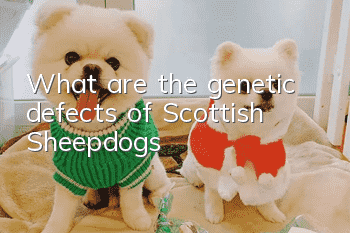What are the genetic defects of Scottish Sheepdogs?

The Collie, also known as the Scottish Sheepdog, is a dog with a flexible and strong body, a stable standing, and an active and lively personality. The broad and thick chest of the dog shows strength, the sloping shoulder blades and moderately curved hocks show speed and elegance, and the face shows very high intelligence. The overall structure of the various parts of the dog's body is perfect and the proportions are harmonious. But like many dogs, it has many genetic defects. So what are its genetic defects?
Scottish Sheepdog
1. Eye deformity
The main manifestation of eye malformation in Collies is incomplete development of the eyes. This disease has been reported all over the world, regardless of coarse or fine hair. This defect is manifested in the incomplete development of the choroid, optic disc or the area connected to it (coloboma). ), thinning of certain areas of the sclera, and retinal detachment. When these deformities occur, clinical manifestations include weakened vision or complete blindness. Most Collies with eye deformities do not show abnormalities in eye vision.
2. Permanent pupillary membrane
During the embryonic stage, the iris first forms into a hard-core mesoderm. The pupil shrinks in the later stages of pregnancy and forms a pupil. If these mesodermal filaments are found in some animals, we call them permanent pupillary membranes. These filaments can often be seen in puppies between 6 and 8 weeks old. But beyond the newborn period it is considered a defect.
In puppies between 6 and 8 weeks old, if these filaments are very large or present for more than 12 weeks, this should be noted in the record book. This disease is very common in Collies.
3. Progressive retinal atrophy
Progressive retinal atrophy is a type of hereditary retinal disease. Characterized by cone and rod agenesis or progressive retinal atrophy. In Collies, agenesis refers to a specific tissue in which both cones and rods are underdeveloped.
Affected animals clinically show symptoms of night blindness at 12 weeks of age, and then complete blindness by about one year of age. All affected animals eventually become blind. Retinal changes can be observed as early as 6 months of age. The final stage is characterized by thinning of retinal blood vessels and hyperreflexia of the choroidal blanket. Pigmentation changes in non-choroidal blanket reflex areas, pale optic disc.
Retinogram can be accurately diagnosed at 10-12 weeks of age. Retinogram is to stimulate the eye with light and observe the changes in the internal potential of the eye to judge the function of the retina. Different light stimulation can be used to distinguish cones. The function of rod and rod cells can be tested before clinical symptoms appear.
liveInherited defects only show the good side to us. We must take more care of Collies.
- How to treat urinary tract stones in dogs? Dogs may need surgery!
- What should I do if my dog has no milk? The owner should check quickly and don’t let the puppies starve to death.
- Dog’s anal gland odor, please note that this is a sign of your dog’s health!
- What are the symptoms of dog pain? How to detect dog pain early
- How to make your dog like to eat dog food Four ways to make your dog fall in love with dog food
- Can dogs digest peach pits if they eat them? Can dogs digest peach pits if they accidentally eat them?
- How to protect your dog’s food? Teach you tips on training your dog
- Why do dogs defecate everywhere? How can dogs stop defecating everywhere?
- What should I do if my dog has lupus? Immune system diseases should not be underestimated
- If your dog's hair is cut and the skin is cut, the flesh is exposed. If the dog's hair is accidentally cut and the skin is cut, it must be disinfected immediately.



